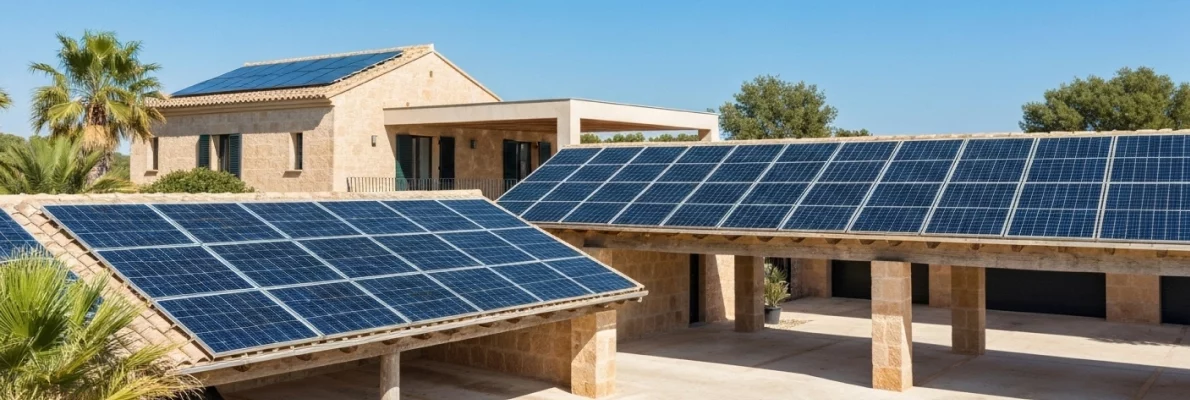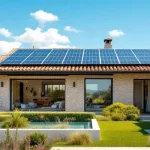Mallorca offers ideal conditions for solar energy — along with a funding and financing environment that you should take advantage of now. Whether you want to modernize your finca, reduce your electricity bill, or make your vacation property more sustainable for guests, the right subsidy programs can offset a large portion of the investment costs. In this article, we explain step by step which grants are available on Mallorca, how much they typically cover, what requirements apply, and how to practically apply for funding.
Why Invest Now?
Europe, the Spanish state, and the Balearic Islands are investing heavily in the energy transition. Through NextGeneration and national programs, funds are distributed to the autonomous communities, which in turn set up regional programs and local bonuses. Many funding windows are currently open — or are being reopened — and the combination of direct grants and tax benefits can dramatically reduce net investment costs. At the national level, the funding frameworks were regulated as part of the Recovery Plan and passed on to the regions.
Available Subsidy Programs for Solar Panels on Mallorca
Here is a short overview of the main levels — national, regional (Illes Balears / CAIB), and local:
National Programs / IDAE:
IDAE (Instituto para la Diversificación y Ahorro de la Energía) manages central funding lines for self-consumption, storage, and innovative projects, which are distributed to the regions. Programs for larger projects and storage are also offered nationally.
Regional Programs (Illes Balears / CAIB):
The Balearic Islands offer specific programs such as FOTOPAR2025 or PITEIB calls for self-consumption and thermal renewable systems — often for residential systems up to 5 kWp and with defined application periods. These programs are aimed at private households and second-home owners in the Balearics (with some exceptions).
Rehabilitation Programs (Energy Efficiency / Building Upgrades):
Special programs for Rehabilitación Energética exist, supporting building envelope improvements, windows/doors, heat pumps, or photovoltaic systems with up to 40% funding (limited maximum amount, e.g., about €3,000 per housing unit). These programs have been extended multiple times or supplemented with additional budgets.
Tax Benefits:
Temporary IRPF deductions (20–60% depending on the measure, with deadlines until the end of 2025/2026 for certain certifications) exist at the state level for energy renovations. The Balearics also offer regional tax reductions (up to 50% in some cases). Usually, only the non-subsidized portion can be claimed additionally for taxes.
Local Discounts (IBI / ICIO):
Many municipalities grant IBI reductions or lower construction fees for homeowners installing solar panels. In some locations, IBI reductions can be up to 50% for several years.
How Much Funding Can You Expect? Examples
Subsidy levels vary by program and project scope. Examples (based on 2024–2025 calls):
- CAIB / Energy Rehabilitation (Program 4): Typically 40% of eligible costs, with a maximum of about €3,000 per housing unit.
- FOTOPAR / PITEIB: Grants for photovoltaic self-consumption for private owners, often up to 5 kWp and additional support for battery storage up to 30 kWh.
- State Tax Incentives (IRPF): Temporary deductions between 20–60% for energy measures. The highest rates require evidence of significant energy efficiency improvements.
- NextGeneration / National Funds: Recent updates have increased subsidies for storage integration, meaning systems with batteries are often more heavily funded.
Compatibility: Grants + Tax Deduction
Grants, tax deductions, and local bonuses are not always fully combinable. Tax deductions usually apply only to the non-subsidized portion of costs or are tied to specific requirements, such as energy certificates or minimum efficiency improvements. Always coordinate applications and tax planning before starting construction.
Step-by-Step Application Process
- Pre-Check: Evaluate your house (primary/secondary residence), minimum requirements (e.g., energy certificate, minimum capacity), and deadlines.
- Offers & Planning: Collect quotes and have an energy consultant or architect verify that the planned measures meet funding criteria.
- Certificates & Documentation: Often required: energy certificate before the project, project documentation, residency certificate, invoices in the beneficiary’s name.
- Application Submission: Submit online via regional portals. Some programs have very narrow submission windows.
- Execution & Accounting: Once approved, complete the installation, prepare final certificates, and submit documentation for reimbursement.
Practical Tips
- Start project planning before beginning construction; many programs exclude ongoing measures.
- Check if storage (battery) is eligible — it often increases the subsidy.
- Carefully plan the order of grants and tax deductions with a tax advisor.
- Take advantage of local benefits, such as IBI or ICIO reductions.
Example Calculation — Solar System Payback
Assume PV + inverter + installation = €8,000; battery + integration = €4,000 → total €12,000. Possible funding impact:
- Energy Rehabilitation Grant 40% → €3,000
- Tax Deduction (on remaining portion) → additional potential savings
- Municipal IBI Bonus → annual savings
Combined, the net investment can drop well below half, plus you gain annual electricity savings and medium- to long-term property value increases. Exact figures depend on project and program compatibility.
Common Mistakes to Avoid
- Starting work before approval → risk of exclusion.
- Missing certificates or invoices in the wrong name → payment may be jeopardized.
- Incorrect combination of grant and tax deduction → possible tax claims. Professional advice is recommended.
Conclusion: Act Now
Mallorca currently offers very good reasons to invest in photovoltaic + storage. Regional grants, national funding, and attractive tax benefits can significantly reduce costs — provided you plan carefully and apply correctly. For a smooth and worry-free process, Simplify Mallorca can support you from initial planning through subsidy applications and final accounting, helping you save money and ensure your solar system is legally and efficiently installed.





